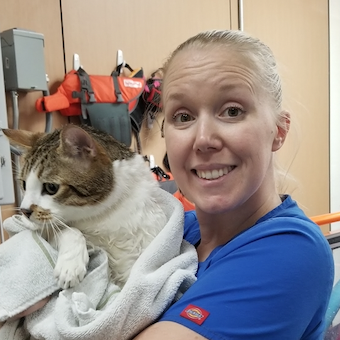Veterinary training is made available when practice-wide improvements and/or advances are warranted. Essentially, this is what gets us from where we are, to where we want to be.
Veterinary coaching, at its core, is a type of regular, structured conversation with a team member to facilitate personal growth.
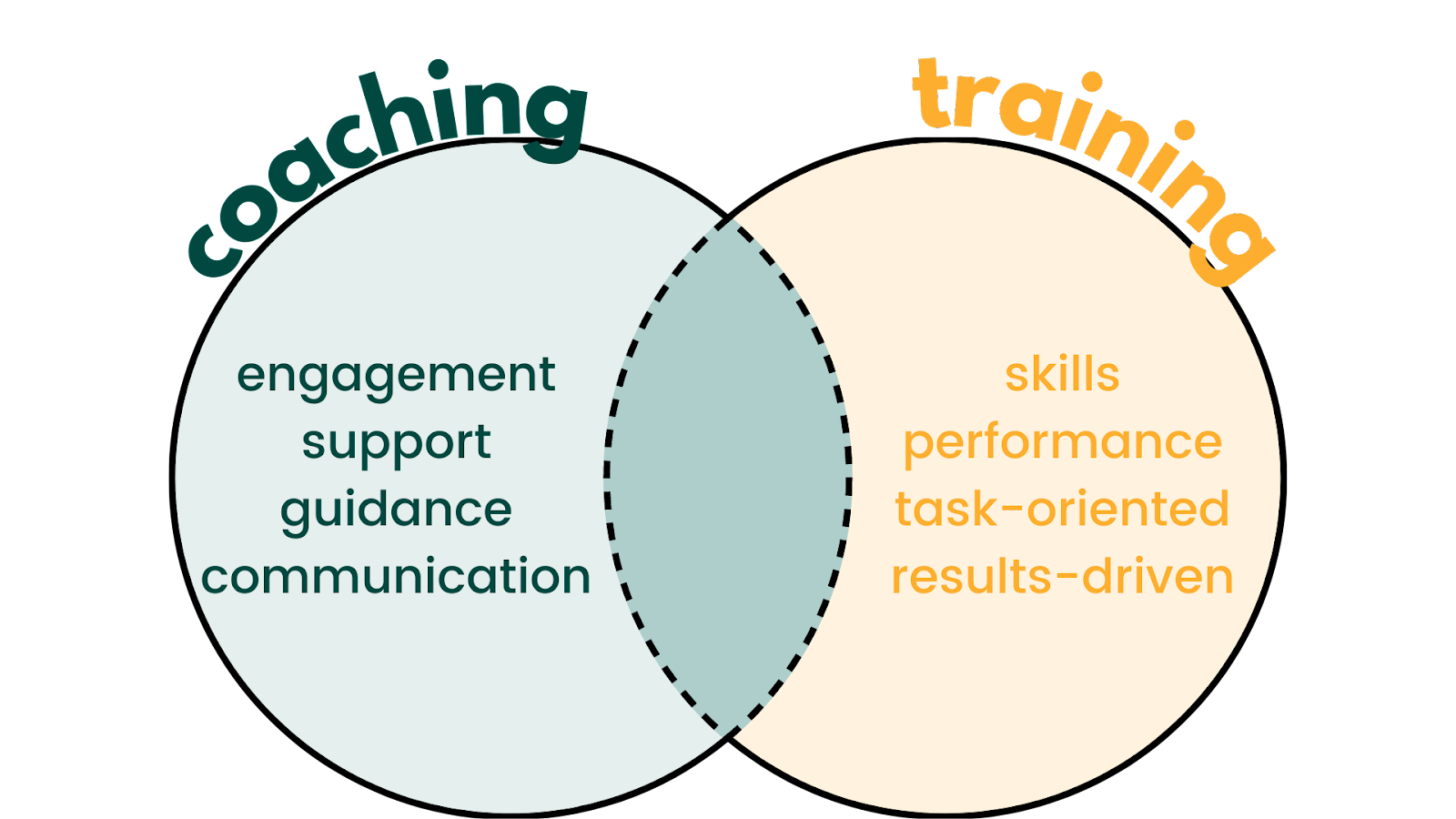
This isn’t a one versus the other scenario, these methods are complementary and vital for completeness when working with either a new addition to the practice, or an existing team member looking to grow.
Both coaching and training are processes, meaning these are dynamic in nature and evolve over time. And as with all things in vet med, they’re subject to change – constantly!
What does veterinary staff training look like?
Training has many different approaches, and by no means is there a one-way-fits-all method.
Remember, training is typically implemented to address & result in overall behavior changes, and no one has the same behavior nor does a practice have the same protocols.
A good training program will lead to standardization of care and an assurance that the teaching of all team members will regularly occur.
Generally, there are five main steps involved throughout the training process, depicted below:
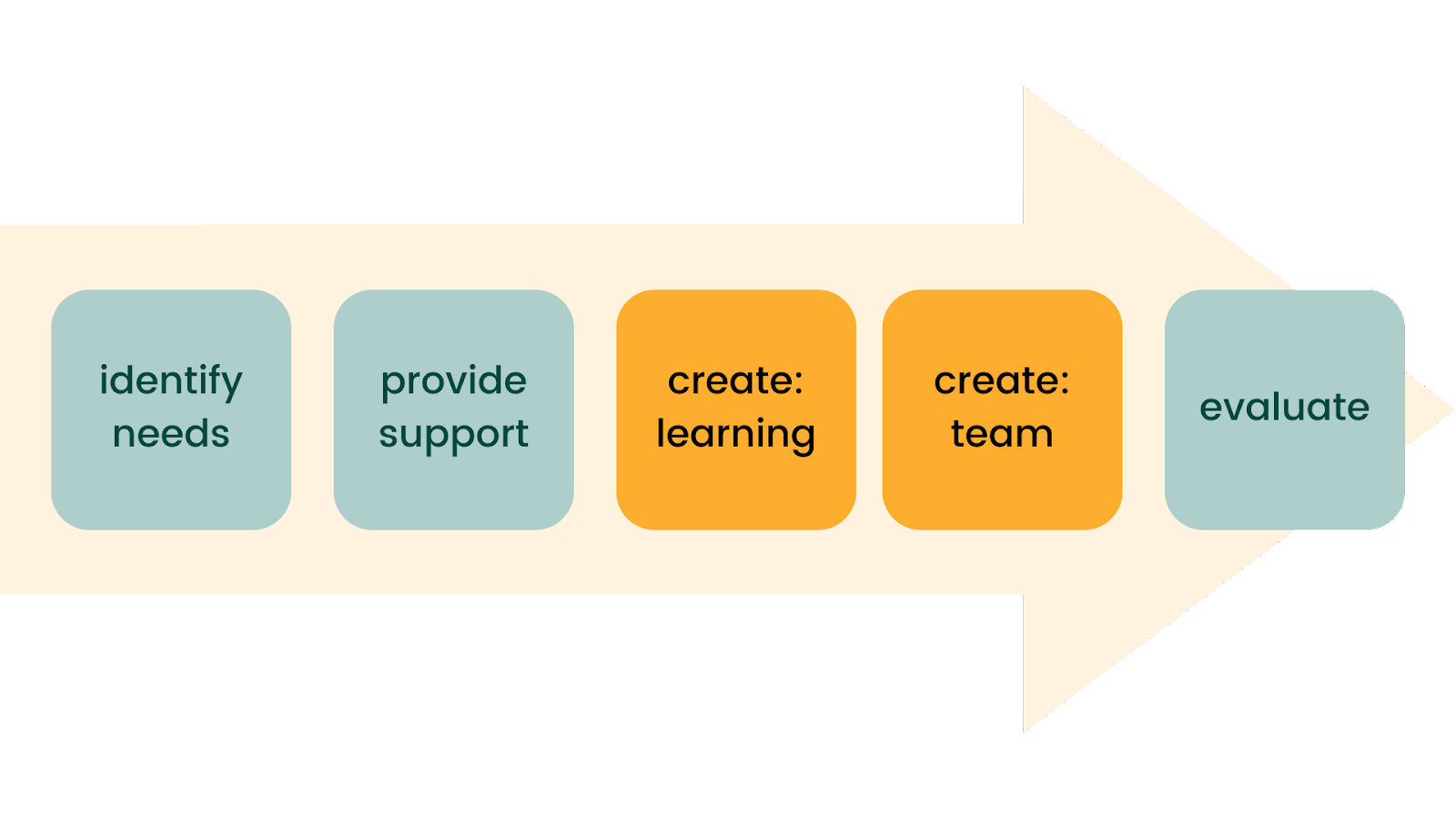
Let’s break this down even further…
1. Identify the needs of your veterinary staff
Identifying the need also comes along with determining the type of need.
Do you have a high or low-performing teammate?
Is this an opportunity for improvement or a new skill?
Once this has been established interventional changes can be implemented.
These types of needs for training will vary from person to person, and you are always going to have extremes at both ends of the spectrum in terms of proficiency, with the majority of trainees falling somewhere in the middle.
Along with the type of need you will be addressing, keep your eyes open for those learning moments or teaching opportunities, and then capitalize upon them!
- Catch your trainees being interested in a particular skill (placing an intracath, for example)
- Direct them to the training materials to help them practice
- Build their confidence in attempting the skill on a live patient.
The most important thing: stay with them throughout the learning process – verbally talk them through it, demonstrate once or twice, then have them perform.
If you have to step away from your trainee, communicate that to another training team member. Never abandon your trainee.
2. Support & ensure the impact of veterinary training
Once the type of need has been identified, the next step is ensuring the impact will be felt by the individual, the team, and the practice as a whole.
The training must then be tailored based upon the details that are required for a specific skill while taking into account the overall impact it will then impart.
This also becomes important when planning for future additions to the team as well as how to address updates to the training program/process in the form of evaluations, CE events, skill sets, etc.
3. Create the curriculum & evaluate
Parts I & II are handled; now ask yourself– is this training really necessary?
Certain issues need other interventions, whether it be a personal matter best handled by the management team, or if the type of skill needed is beyond the realm of the practice.
What does veterinary staff coaching look like?
Coaching stems from the belief that true growth is not an external factor, but one that is very much internal.
The key pieces of coaching are:
- guiding your team to grow their existing strengths
- creating flexibility in your workplace
- shifting your team and yourself into a growth mindset
- implementing & fostering self-awareness
- developing a sense of commitment to one’s self-achievement (and the achievement of the team as a whole)
Coaching is most efficacious when each team member is fully invested and works to produce their own solutions to the situations and/or challenges they are faced with.
Empowerment thrives here, as each teammate is given the choice to show up and hold one another accountable.
Motivation also comes into play at this juncture. For your team to see each other’s progress, wants to proceed, grow, and change. Goals are set, then achieved. A sense of independence emerges as the team sees their self-reliance thrive and in turn begin to foster it amongst themselves.
Put veterinary coaching into action
Coaching is at its core a method to impact and/or elicit change that will get you and your team to the desired outcome.
The coaching process is an active one.
You can see, hear, and feel the movement from a stagnant state to a more dynamic and evolved place.
Both you, as the coach, and the team member being coached, are fully immersed in an ongoing learning cycle — leading to more effective workplace behaviors and moving the entire practice forward.
Each of us, as coaches, must remember that we are here to help our teams to develop their already existing strengths and to build up areas in which more growth is needed.
Looking back won’t help any of us, and to maintain that forward momentum an Act-Reflect-Learn-Plan approach (shown below) becomes of vital importance.

A collaborative effort with a coach and their team that incorporates this model — along with consistent & constructive conversations — leads them to improved accountability with one another and the increased likelihood of positive change for each team member.
Each segment comes with engagement questions – can’t do any of these without either outward or self-inquiry!
When reflecting:
- What occurred?
- What worked?
- What didn’t?
As we’re learning:
- What was learned?
- What does ________ mean?
- Are there other ways to look at/approach this?
Amidst the planning:
- What comes next?
- How do we change our thought processes?
- What do we need to DO in order to BE different?
As you probably noticed, there isn’t any further detail given for “Act”. This was intentional because doing something (acting) – is enough.
Necessary skills for awesome veterinary coaches
There are so many that are essential for a strong and authentic coach to possess, but the top three that truly stand out are those of active listening, impactful inquiry, and honest conversations.
Active listening
Active listening means that we as coaches MUST be engaged, attentive, and present with our team. Basically, be there and nowhere else.
This is particularly challenging in our practice settings of [organized] chaos and the necessities of multitasking. However, we must do our best to mitigate not only external distractions but internal ones as well.
How does one practice active listening?
This is where self-awareness work comes in. Checking in with ourselves and recognizing where we are at – both physically and mentally – before having any type of conversation is crucial to establishing a connection and the trust that is needed to maintain the precedent for upcoming coach/team interactions.
Try these tips:
- Take a seat, relax.
- Note your posture & be more physically open.
- Be aware of your facial expressions.
- Match them to the tone and topics of conversation.
- Maintain eye contact, naturally.
- Don’t stare!
- Ensure personal space for everyone in the conversation is met.
- Keep leading words and/or gestures to a minimum.
- This keeps the flow going.
Impactful inquiry
Impactful inquiry is a strong statement on its own, and really lends itself to growing insight and getting those brain waves crashing in. When a coach adopts the mantra of “ask, don’t tell”, this gives the team member the opportunity to delve further on their own to ask of their coach and challenge themselves.
Think of it this way, when an idea is all your own instead of something you’ve been told to do, or it’s an established practice because “that’s the way we’ve always done it” aren’t you more likely to be invested and to make things happen? Absolutely.
The Coaching Commitment Continuum (below) from Jeff Thoren’s adaptation of Max Landsberg’s conceptualization shows the role of inquiry in establishing and fostering commitment, then turning it into action.
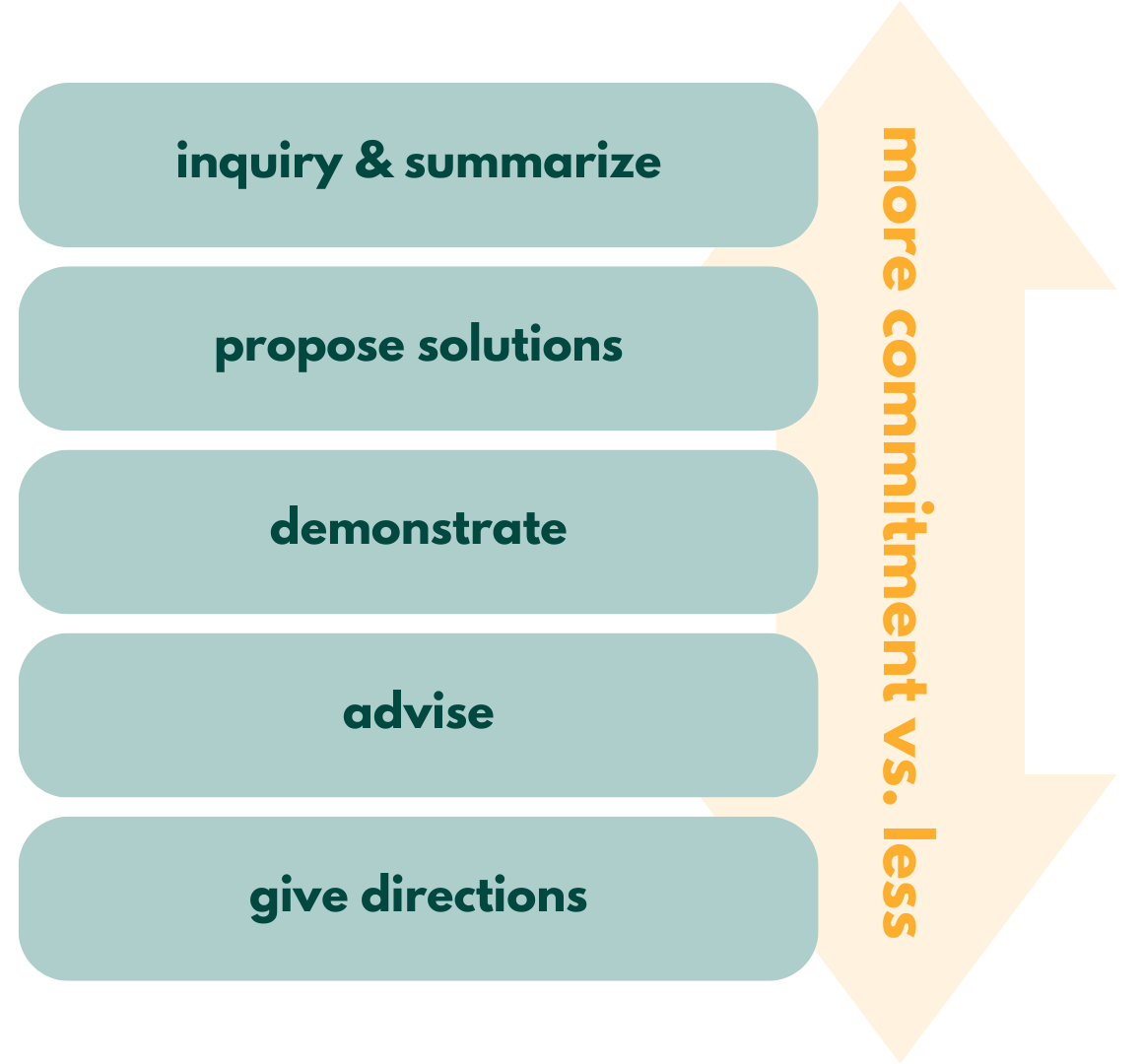
Yes, there’s a theme here - action occurs after thought and discussion take place.
So, what exactly is impactful inquiry?
These types of questions are open-ended; they cannot be closed off with either a yes or no answer. The inquiries must be on the team member’s time, and from a place of genuine seeking. Conversation and further questioning in turn need to follow where the team member wants/needs them to go.
Another way to consider this, is that impactful inquiry stems from a place of intent, as in what you’re looking to accomplish from this conversation. This means that expectations and preconceived notions are out, this is not the time to get into fix-it mode, nor is it a time for you as the coach to shine with all of your radiant knowledge.
To truly be effective for our team members’ growth and for their understanding to deepen & flourish, we – the coach – need to get our heads on right and deflate our egos completely.
Honest conversations
Honest conversations are at times raw, always real, and by necessity, direct. This helps our team members develop broader perspectives on what’s going on for and with them and offers new options for action to move them forward effectively. This is the point where you can now lend your insight because you’ve already implemented active listening and impactful inquiry, your team member is now ready to hear what you have to say.
From a metaphorical sense, you are now acting as a mirror for your team member to reflect back at them what they may not be able to see fully on their own, yet. These conversations where you relay what you’ve seen or heard are the impetus for change, and further develops your team member’s self-awareness.
By sharing your perspective, clearly, honestly & authentically, you enable them to do the same for their teammates; those to whom they are similar, and those with whom they differ.
When our discussions take this active shift towards transparency within our coaching mindset, the struggle for approval and any attempts to persuade fade away. Instead, there is an ebb and flow to the tide of conversation that allows for an interchange – not an exchange – of thoughts, ideas, and feelings.
Each of you, coach, and team member, are present and engaged with one another and are then able to share honestly and actively.
Honest conversations should include the majority, if not all, of the following attributes:
- Direct
- Clear
- Succinct
- Well-thought out
- Include what the coach has either noticed or observed
- Non-judgmental
- Challenging; when appropriate
- Encouraging
To sum it up, collaborative coaching involves a coach who listens, asks the right questions in the right way, and talks to their team in such a way that each team member becomes aware of who they want to be, what they want to do, and how they’re going to accomplish it all.
Now, go be awesome coaches & trainers!
By expanding our team members’ choices for effective action, we thereby develop their trust in themselves so that they can in essence pay it forward, in their own intentions and toward those of their team.



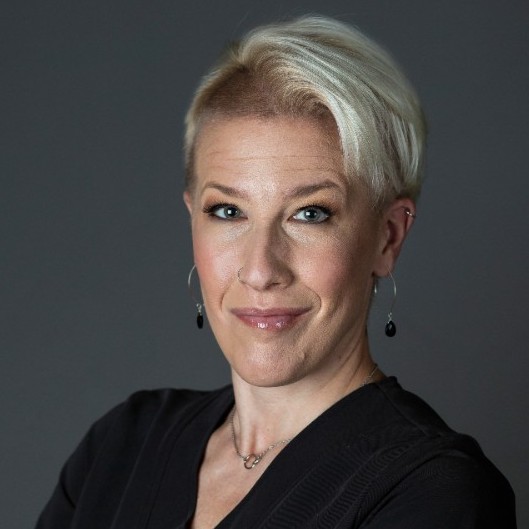
.gif)

